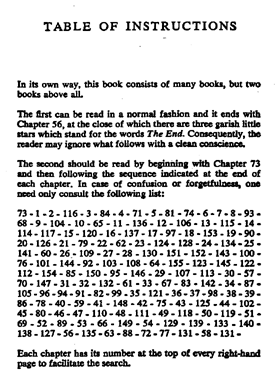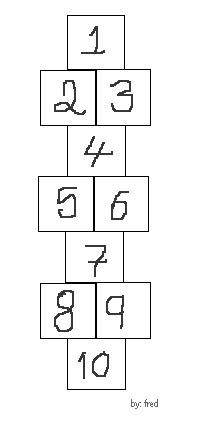 J. Cortázar
J. Cortázar
 J. Cortázar
J. Cortázar
When I started conceiving this project about hypertext, I recalled a novel of the Southamerican writer, Julio Cortázar, called “Rayuela,” published on 1963. This novel, which in English is called Hopscotch, instead of a table of contents, it has on its first page this “Table of Instructions”:

The instructions provide for two possible reading paths. One is reading it in a linear fashion like any other book, with the exception that the book will end with chapter 56, leaving nearly two thirds of the chapters (the book have a total of 155 chapters) without being read. The other alternative is following the list of chapters given on the table of instructions. This list contain the numbers of all the chapters of the book, but one, in a random-like fashion ending with two chapters that refer to each other endlessly (“131-58-131- ”).
The structural experimentation in Hopscotch have an evident relation with hypertext. It can be considered a hyperbook. Cortázar gives the reader the option of selecting his/her reading path and the sensation of browsing through the novel’s pages in search for the corresponding chapter. That makes the Hopscotch to have strong structural similarities with a web-like hypertext network.
Although, our current concern with Hopscotch is in a structural and technical level it is interesting to note that its content and characters are related to its structure by the use of different allusions through the novel. The protagonist, Horacio Oliveira, is a writer and bohemian who makes several allusions to non-linear ways of thinking or writing, an example is when he said: “pages 78, 457, 3, 271, 688, 75, and 456 of the Dictionary of the Spanish Academy have all that is needed for the writing of a hendecasyllable by Garcilaso” (Cortázar, Hopscotch, p. 389). His story is the story of searching for his beloved one, La Maga, and the metaphor for this search is the game of hopscotch (la rayuela, la peregrina o el juego del arroz con pollo as called through different Latin American countries). That game is play by jumping back and forth through a grid of squares drawn on the floor. Hopping back and forth and back again all the time, an infinite number of hops can be done in different combinations, but the grid remains the same, usually limited to only ten squares.

The structure of this game may appear silly, but it has some metaphoric relations with hypertext. Derrida makes use of playing when approaching the question of the text. "Meaning is a function of play." (Dienst, p. 132) Différance, the instant movement from the presence to the absence of meaning (and back again) is a kind of game: “What is written as différance, then, will be the playing movement that “produce”...” (Derrida, Margins of Philosophy, p. 11). The quest for meaning, for Derrida, is the playing of breaching the text and the context; is a game of hopping back and forth like in hopscotch. In hypertext, the reader hop back and forth through different nodes in order to construct meaning. But the meaning per se is never there... meaning emerges between the hopping among nodes. Thus, in hypertext meaning is also a function of play: playing by hopping back and forth and back again like in the hopscotch.
Not only “Hopscotch’s” structure is analogous to hypertext and not only the game of hopscotch is a metaphor to it, there is another aspect introduced by Cortázar that deserves our attention. In the story “Another Bachelor Machine” of his book: “Around the Day in Eighty Worlds” he reveals the fact that “Hopscotch” is a novel which requires a machinic reading. As I have stated, hypertext is a technology of writing and Derrida have contended that “writing most be a machine.” In a similar way Cortázar argues that the “Hopscotch” is also a machine. He said this by telling us the story of the “RAYUEL-O-MATIC,”a machine designed for the reading of “Hopscotch.” The “RAYUEL-O-MATIC ” consists of an electrical furniture piece which contains 155 drawers, one for each chapter of the novel and six buttons. The buttons give the reader the option of reading the novel either on the linear or on the non-linear way, it also provides for an option which gives the reader the freedom of selecting any drawer (chapter) he/her desires. Several sketches of the machine are presented in the chapter.
The importance of this story is that it puts Cortázar very close to Derrida by acknowledging that “writing must be a machine,” a hypertextual machine. Therefore, Cortázar is a very important figure to the development of hypertext by using a non-linear structure of writing, the metaphor of meaning as a function of play, and a machine as a reading device. Without doubts, Cortázar was thinking in terms of hypertext years before the advent of computers.
About the Question of Narrative